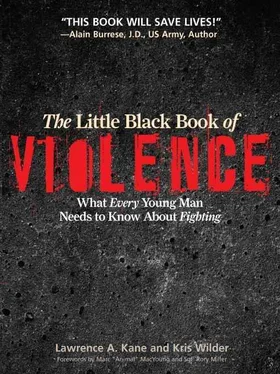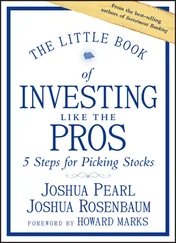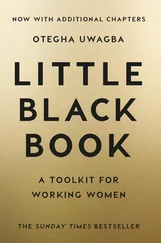• MacYoung, Marc. Violence, Blunders, and Fractured Jaws: Advanced Awareness Techniques and Street Etiquette. Boulder, CO: Paladin Enterprises, Inc., 1992. This book truly helps readers refine and strengthen their situational awareness for survival on the street. It can help you instantly and easily identify the fighters, hustlers, workers, spectators and troublemakers using the same tricks that bouncers, law enforcement officers, prison guards, drug dealers, bikers, and street people utilize so effectively. It goes in-depth into subjects like family group operating systems, personal operating systems, utilizing and refining your personal radar, turf, territory, personal space, rural versus urban reactions, gambling, tacking, scarring, piercing, tattoos, etiquette, eye contact, and other issues that are commonly known only to a very small segment of society. Reading this book is a very eye-opening, mind-expanding experience.
Sergeant Miller has studied martial arts since 1981. He has received college varsities in judo and fencing and holds mokuroku (teaching certificate) in Sosuishitsu-ryu jujutsu . He is a corrections officer and tactical team leader who teaches and designs courses in defensive tactics, close quarters combat and Use of Force policy and application for law enforcement and corrections officers. A veteran of hundreds of violent confrontations he lectures on realism and training for martial artists and writers. Both Wilder and Kane have trained with him and know first-hand that Miller truly knows what he is talking about.
• Miller, Rory A. Meditations on Violence: A Comparison of Martial Arts Training and Real World Violence. Wolfeboro, NH: YMAA Publication Center, 2008. Violence is the soul of chaos. Martial arts are clean and structured, even simple in a way, yet somehow one arose from the other. Maybe it is the human need for structure that somehow converted a bloody, smelly, terrifying experience of combat into the beauty and structure of kata . Experienced martial artist and veteran correction officer Sergeant Rory Miller distills what he has learned from jailhouse brawls, tactical operations and ambushes to explore the differences between martial arts and the subject martial arts were designed to deal with—violence. This book is a refreshingly frank, honest, and in-depth assessment of the subject. Readers will learn how to think critically about violence, how to evaluate sources of knowledge, and how to identify strategies and select tactics to deal with it effectively. One of the most important aspects of the book is Miller’s insights on how to make self-defense work. He examines how to look at defense in a broader context as well as how to overcome some of your own subconscious resistance to meeting violence with violence. It’s truly outstanding stuff!
Peyton Quinn is considered by many the “dean” of barroom brawling. He began his training in formal martial arts systems in 1964, eventually achieving black belts in karate, judo, and aikido. While he continues to respect and explore Asian martial arts systems, his real-world experience has shown him that for most people, training in martial arts alone is not enough for real fighting. He has written numerous books and created several DVDs on the subject.
• Quinn, Peyton. Bouncer’s Guide to Barroom Brawling: Dealing with the Sucker Puncher, Streetfighter, and Ambusher. Boulder, CO: Paladin Enterprises, Inc., 1990.
Quinn’s writing style is very similar to Marc MacYoung’s, right down to the expletives. Similarly, his no-nonsense advice is hard hitting and right on point. This excellent book begins by pointing out that avoiding violence is an essential technique in and of itself, just as valuable as knowing how to throw a good punch or deliver a strong kick. The fundamental elements of avoidance tactics section is important information. There are also solid sections on the realities of fighting that, as experienced warriors understand, is nothing like what you see in the movies. It is ugly stuff best avoided. Even when you triumph, there are legal (and medical) ramifications that can come back to haunt you. The author’s “stay out of prison plan” is excellent. Advanced practitioners should appreciate this information but won’t get a lot out of the rest of the book. The principles of defensive and offensive techniques are fairly basic, but well written and comprehensive. He covers striking, grappling, and movement in good detail. Chapter 7, which covers how to select an appropriate martial art for your own personal safety, is an outstanding overview for beginners that can help you find one.
• Quinn, Peyton. Real Fighting: Adrenaline Stress Conditioning through Scenario-Based Training. Boulder, CO: Paladin Enterprises, Inc., 1996.
In a violent encounter, your heart rate can jump from 60 or 70 beats per minute (BPM) to well over 200 BMP in less than half a second. While this adrenal dump gives you a survival edge by making you more resilient during combat, it severely degrades your motor skills, hand-eye coordination, and sense of timing making complicated techniques very challenging, if not impossible, to perform. This stress can even cause you to experience tunnel vision, suffer temporary memory loss, become hyper-vigilant, lose rational thought, or even lose the ability to consciously move or react. If your training does not account for adrenaline, it will be of dubious value on the street. That’s what this excellent book is all about. Contents include the fear factor, combat mindset, muscular memory, strategy, training methods, scenario based training, and using weapons.
Ayoob, Massad. In the Gravest Extreme: The Role of the Firearm in Personal Protection . Concord NH: Police Bookshelf, 1980.
Ayoob, Massad. The Truth About Self-Protection . New York, NY: Bantam Books (Police Bookshelf), 1983.
Christensen, Loren and Dr. Alexis Artwohl. Deadly Force Encounters: What Cops Need To Know To Mentally And Physically Prepare For And Survive A Gunfight . Boulder, CO: Paladin Enterprises, Inc., 1997.
Christensen, Loren. Far Beyond Defensive Tactics: Advanced Concepts, Techniques, Drills, and Tricks for Cops on the Street. Boulder, CO: Paladin Enterprises, Inc., 1998.
Christensen, Loren. Gangbangers: Understanding the Deadly Minds of America’s Street Gangs . Boulder, CO: Paladin Enterprises, Inc., 1999.
Christensen, Loren. Riot: A Behind-the-Barricades Tour of Mobs, Riot Cops, and the Chaos of Crowd Violence . Boulder, CO: Paladin Enterprises, Inc., 2008.
Christensen, Loren. Surviving Workplace Violence: What to Do Before a Violent Incident, What to Do When the Violence Explodes . Boulder, CO: Paladin Enterprises, Inc., 2005.
Consterdine, Peter. Fit to Fight: The Manual of Intense Training for Combat . Chichester, UK: Summersdale Publishers, 1998.
Consterdine, Peter. Streetwise: A Complete Manual of Security and Self Defense . Chichester, UK: Summersdale Publishers, 1998.
Consterdine, Peter. Travelsafe: A Travel Security Guide for the Tourist and Business Traveler . Leeds, UK: Protection Publications, 2001.
Covey, Stephen R. The 7 Habits of Highly Effective People . New York, NY: Simon and Schuster, 1989.
DeBecker, Gavin. The Gift of Fear: Survival Signals That Protect Us From Violence . New York, NY: Dell Publishing, 1998
Grossman, Dave and Loren Christensen. On Combat: The Psychology and Physiology of Deadly Conflict in War and Peace . Belleville, IL: PPCT Research Publications, 2004.
Hoffman, Yoel. Japanese Death Poems: Written by Zen Monks and Haiku Poets on the Verge of Death . Rutland. Vermont: Tuttle Publishing, 1986.
Читать дальше











